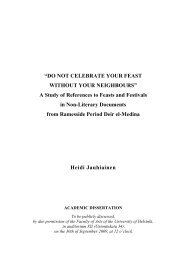BIA
bia51
bia51
You also want an ePaper? Increase the reach of your titles
YUMPU automatically turns print PDFs into web optimized ePapers that Google loves.
MAI 2015<br />
paying for and their complaints about what<br />
they were receiving instead. Subsequent to that<br />
case, reforms were put into place and the<br />
statement, “one god in one jar” was written,<br />
indicating there could only be one whole<br />
animal per mummy.<br />
At the University of Manchester, MCKNIGHT<br />
has a different point of view. Though many of<br />
the casings were empty, others were filled with<br />
partial skeletons as well as other organic<br />
materials, such as sticks, eggshells, mud, reeds<br />
and feathers. According to her, these items<br />
were readily available around the embalmers<br />
and represented the animals for which the<br />
mummies were made. “They [empty casings]<br />
were special because they had been in close<br />
proximity with the animals-even though they<br />
weren’t the animals themselves,” she told BBC.<br />
Ancient Egyptians were systematically<br />
mummified in preparation for the afterlife. A<br />
National Geographic article on why humans and<br />
animals were similarly mummified explains that<br />
though the mummification of animals was not<br />
for the afterlife, they were an important burial<br />
ritual as they represented religious offerings to<br />
the gods. The animals were often as well<br />
preserved as humans, as it was believed that<br />
animals were indistinguishable from humans<br />
with regards to having a soul. Animals were<br />
linked to the gods and it was a common belief<br />
that some were incarnations of some of the<br />
most powerful gods in Ancient Egypt.<br />
Cats were considered the incarnation of<br />
Bastet, the protector of women and goddess of<br />
joy and music. The Apis bull, which was a<br />
revered animal in Egypt, was a representation<br />
of Osiris, the god of embalming and<br />
cemeteries. Hawks were seen as manifestations<br />
of Horus, the god of light and the ibis<br />
represented Thoth, the god of wisdom and<br />
learning. These animals, in addition to lizards,<br />
beetles and pets, such as baboons, monkeys<br />
and dogs were often buried with humans as<br />
offerings to the gods.<br />
The embalming materials used for animals<br />
were likened to those used for humans.<br />
Ingredients such as animal fats, oils, beeswax,<br />
sugar gum, bitumen and pine tree resin were<br />
all used to preserve the animals after death. As<br />
with humans, the organs were typically removed<br />
and the carcasses were rubbed with salt to<br />
remove any excess water, thereby minimizing<br />
the presence of microbes. The oils and resins<br />
were then applied to keep moisture out.<br />
Dr. Campbell PRICE is the curator of Egypt<br />
and Sudan sector at the Manchester Museum.<br />
“We know the Egyptians worshipped gods in<br />
animal forms and an animal mummy allowed<br />
you some connection with the world of the<br />
gods,” BBC quoted PRICE as saying. “You would<br />
go to a special site, buy an animal mummy,<br />
using a system of barter. You’d then give it to<br />
a priest, who would collect a group of animal<br />
mummies and bury them.”<br />
Between 800BC and AD400, there was a<br />
thriving animal mummy industry in Egypt.<br />
Scientists believe up to 70 million animals were<br />
mummified during that time. This would indicate<br />
that there was a very elaborate and specialized<br />
breeding program, as many of the animals<br />
were killed specifically for burial and were quite<br />
young at the time of death.<br />
BBC’s recent coverage of the findings at the<br />
University of Manchester seems to indicate the<br />
suspicion of corruption has been assuaged. The<br />
demand for animal mummies, scientists<br />
suspect, most likely outweighed the supply at<br />
the time. This could have led to the practice of<br />
making partial or organically-filled casings that<br />
resembled the animals people wished to honor.<br />
Unlike what the Brooklyn Museum<br />
determined, MCKNIGHT does not believe<br />
corruption was a factor. “We don’t think it’s<br />
forgery or fakery,” she said. “It’s just that they<br />
were using everything they could find. And<br />
often the most beautifully wrapped mummies<br />
don’t contain the animal remains themselves.”<br />
Despite the University of Manchester’s<br />
stance on the matter, it is still possible that<br />
both museums are right. As the Saqqâra<br />
document indicates, there was some<br />
controversy concerning mummified remains of<br />
animals, suggesting a strong correlation to<br />
corrupt practices. On the other hand, many<br />
people may have purchased mummies with only<br />
partial remains or empty casings because it<br />
was a less-expensive alternative to a whole<br />
animal during a period of shortage.<br />
“This was an extremely important economic<br />
phenomenon,” Egyptology curator at the<br />
Brooklyn Museum Edward BLEIBERG told<br />
Archeology Magazine. “There was a lot of<br />
<strong>BIA</strong> LI — Janvier/Juin 2015 114



